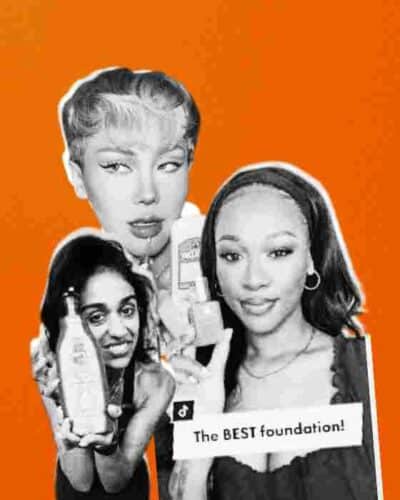Say what you want about the youth of today, but there’s no denying their power and influence within the social and digital landscape. Many brands are starting to catch on, from employing young creators in creative in-house roles, to diversifying their marketing to meet the needs of young consumers, it seems the targeting of the next generation has officially begun.
But who is the “next generation” anyway? Is it Gen Z? Is it Gen Alpha? We would argue it’s both. In this blog we’re discussing Gen Zalpha, how brands like Claire’s are gearing up to target younger audiences, and how platforms like Roblox are the key to connecting with our young peers.

Contents
Gen Z and Gen Alpha are not so different
Why brands need to pay attention to Gen Zalpha
What are we seeing right now between brands and Gen Zalpha?
—
Who are Gen Zalpha?
Much like Zillenials, a micro generation where millennials meet Gen Zers, Gen Zalpha is an amalgamation of Generation Alpha and Gen Z; anyone born after 1996.
It’s difficult to determine where the term “Zalpha” first started appearing in modern marketing. Many believe it was Kristin Patrick, chief marketing officer at teen jewelry and accessory retailer, Claire’s, who popularized the phrase. Some months later, it would be Claire’s capitalizing on this young demographic once again, but we’ll get to that.
—
Gen Z and Gen Alpha are not so different
While Gen Z is often described as having grown up online, Gen Alpha was born online.
In many ways, Gen Z and Gen Alpha are very alike. Both generations have embraced diversity, and stand for it. They aren’t afraid to question their gender. They’re highly creative, especially on platforms like TikTok. And, they’ve grown up engulfed by the digital world.
They’re big gamers
Both generations are avid game enthusiasts, with 88% of Gen Zers and 92% of Gen Alphas reporting playing games. Among their favorite gaming titles are Fortnite, Minecraft, and Roblox.
Short form is king
Gen Z and Gen Alpha share pretty similar social media consumption patterns, too. Gen Z paved the way for Gen Alpha in the sense of short-form content is king. Gen Alphas love to watch TikTok and YouTube Shorts, just like their Gen Z counterparts.
They’re not afraid to speak up
Gen Z aren’t the only ones campaigning for change. Gen Alpha kids are well-versed and forward-thinking when it comes to social issues. They’re more inclined to believe that everyone should be treated the same, and consider it their top priority when asked what’s most important to them.
They feel pressure, particularly around appearance
As we speak, young shoppers are raiding Sephora for sophisticated skincare and scrolling TikTok for the latest in beauty. We’ve now got eight, ten, and twelve year-olds out there perfecting their multi—step skincare routine.
With teens growing up almost entirely within the social and digital world, there’s a lot more pressure on young people to grow up fast. Teens today have ‘get ready with me’ content from their friends, airbrushed and filtered photos, and round the clock influencer content to compete with. It comes as no surprise that we’ve got 13 going on 30 year-olds when societal pressure to “look good” is at an all-time high amongst our young peers.
—
Why brands need to pay attention to Gen Zalpha
The internet-native Zalpha generation is a prime target for brands for another reason: its potential spending power. Zalphas’ spending is predicted to grow three times faster than other generations by 2030.
The generation is also expected to make up one-third of luxury consumers by the end of the decade due to its “precocious attitude toward luxury,” according to a report by Bain & Company published in January.
Outside of their love for luxury, skincare, and impending boom in spending power, there is a more significant reason for brands to pay attention to Gen Zalpha. They’re the future. Zalphas are more than part of the digital world, in a way a symbiotic relationship exists between this generation and the online world. As they get older, new technologies will emerge, and become part of their lives, their experiences, their attitudes, and expectations of the world. These are the technologies that will influence future innovation. Shopping habits will change, consumption habits will change, and our young consumers will be at the heart of it all.
—
What are we seeing right now between brands and Gen Zalpha?
Claire’s revives its image with “The Collab”
Claire’s has seen something of a revival since it filed for bankruptcy in 2018. The brand has reinvented itself, going from a household name in any mall or shopping outlet to Parisian boulevards, and the metaverse.
Claire’s latest campaign, aptly titled “The Collab” is a year-long effort to acclimatize in the worlds of social and influencer, and to connect with the next generation of customers, Gen Z and Gen Alpha.
The campaign is a celebration of the creativity and influence of Gen Zalpha. These younger audiences are Claire’s primary target audience, and to reach them, Claire’s enlisted content creators ranging from seven years-old to early 20s.
Amongst its ranks, The Collab features a unique span of young talent including 7-year-old Ayla Palmer, creator of the AY fashion brand, and 15-year-old fashion designer Ashlyn So, who was recently named in Vogue’s top three designers to watch.
Claire’s plans to harness a lot more than just inspiration from its collaboration. In fact, these creators will have influence in the creative direction across Claire’s wider marketing activations, from its social content to its in-store activations.
The Collab serves as a platform for younger generations to share their passions and accomplishments with audiences on a global scale. Claire’s is empowering the next generation by giving them a voice, which in turn is revitalizing the brand and helping them tap into these diverse, creative, and tech savvy young audiences.
Gen Zers as Creative Directors?
Before Claire’s handed its creative direction over to tweens and teens, brands like Nerf were hiring digitally native creators to run their TikTok channels.
Looking back two years, Nerf’sTikTok channel was raking in millions of views thanks to its “Chief TikTok Officer”, a then 21-year-old Sophie “Lightning” Jamison. Estee Lauder-owned brand Too Faced followed a similar blueprint last year, bringing in beauty and fashion TikToker Sara Echeagaray as its first ever Creative Director in Residence.
Bringing in creators to fill Creative Director roles is nothing new. We’ve seen this with Molly-Mae at Pretty Little Thing, Nerf, and Too Faced, and now again with what Claire’s is doing. What we are starting to see is the age of these creators is beginning to drop quite significantly, which means younger consumers are beginning to pop up on brand radars throughout multiple industries.
Entering the world of Roblox
With a daily player base of around 70 million, Roblox is one of the most popular video games out there. Over the past couple of years it has earned a reputation as one of the most prevalent metaverse spaces, a virtual world where people are represented by avatars and can make economic decisions. The Roblox player base is heavily skewed towards a blend of Gen Zers and Gen Alphas, making it an ideal tool for brands to immerse themselves in if they want to reach a younger audience.
If the idea of a cartoon world, rife with teens and tweens sounds daunting, it may be of some solace to know that Roblox has become a helpful marketing tool for many major brands. The likes of Chipotle, Gucci, and NYX Cosmetics have set up their own virtual spaces within Roblox in recent years, using the metaverse to engage a much younger audience than is available across other digital platforms.
Claire’s, too, has experimented with new technologies to reach a more digitally savvy generation. When relaunching its piercing business it used AI to let shoppers curate their own looks. In 2022 the brand took its first steps into the Roblox metaverse.
The brand created a transformative digital world, designed to empower self-expression and personal style. Players who joined the “ShimmerVille” 3D world could create their own personalized avatars, explore, play, shop and connect with other users. This experience stretched into the physical world through products and opportunities, such as in-game jewelry being made available to purchase in real life. ShimmerVille marked the brand’s investment in a ‘physical’ future, and its commitment to providing a platform for everything Gen Zalpha stands for.
Coming back to our earlier point about beauty conscious teens. One of Roblox’s biggest draws for its young player base is the ability to play as an avatar, a completely customizable character that players view as a virtual extension of themselves. These avatars allow young people to explore different parts of themselves, experimenting with different clothes, hairstyles etc. Doing this in an anonymised environment gives confidence to try these different experiences before doing it in real life. Gen Zalphas have a heightened perception of beauty standards, and because of this more young people are tuning into virtual spaces in the form of avatars to find a sense of identity.
With this in mind, it makes sense that fashion labels and beauty brands are setting up virtual spaces in Roblox to get young consumers to try out their products. In these spaces, brands are meeting with younger consumers in the places they’re already spending time, and giving them the freedom to express themselves. By connecting with them like this, these brands are not only fostering a deeper connection with these audiences, but converting them into loyal followers that translate to offline advocacy, as well as online.
—
Concluding thoughts
The rising influence of Gen Zalpha, driven by their spending power and symbiotic relationship with the digital world, positions them not just as consumers but as the architects of future innovations and trends. As brands explore avenues like Roblox to engage with this audience, it becomes evident that understanding and aligning with Gen Zalpha is not just a marketing strategy but a necessity for staying relevant and impactful in the ever-evolving consumer landscape.
Brands should take inspiration from Claire’s and how they’re providing young people with a voice. Gen Zalpha is incredibly powerful, but they’re also complex, reaching these audiences is far from easy. By meeting them on their terms, and giving Zalphas the platform for self-expression, Claire’s has revolutionized its brand, and teed up success for its next generation.
—
We’ve been helping the world’s biggest brands diversify their target audience over the last eight years. Find out more on how we can help you target Gen Zalpha and more through social first marketing!





